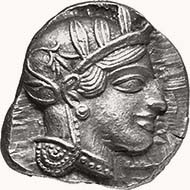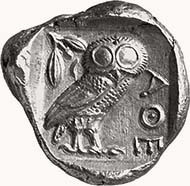by courtesy of Dr. Hans Voegtli / ACAMA
ATHENS. Tetradrachm, 454-406 B.C. Head of Athena r., wearing Athenian helmet; on helmet, three leaves of olive and tendril. Rev. Owl standing r., behind twig with two leaves and fruit. 17, 20 g. Svoronos pl. 16, 5. From sale Münzen & Medaillen Deutschland 9 (October 4 and 5, 2001), 16.
In 479 BC the Greeks defeated the Persians at Plataiai. At that time nobody dared to hope that the fight was so soon to end. On the contrary, every Greek city was afraid of the Persian king, who had vast resources at his disposal. He was feared to raise another army in order to conquer the whole of Greece. Something had to be done to prevent that. Therefore some Greek cities founded a league to defend each other against any Persian attack. Athens became the leader. Most of the members came from Asia Minor and from the Aegean Islands. They were scared to be the first, whom the Persians would attack. They provided either ships, or money to pay for the costs of the ships. The treasury was stored in the temple of Apollon at Delos. At the same place the members held their meetings. This geographic center gave the name to the whole association: Modern historians call it the Delian league.
The Parthenon of Athens – paid with Athenian tetradrachms.
At the very beginning this association was a group of equals. But slowly Athens became predominant. A lot of cities preferred to pay an amount of money rather than to equip and man a ship for the whole of the year. Athens was willing to build and maintain a fleet on behalf of the whole of the league. Its economy boomed because of the fleet, and Athenian generals commanded the ships that were financed by the league. In 454 the Athenians forced the league to transfer the treasury from Delos to Athens. Now the Athenian public meeting had control over the means of the allies. Their voluntary contributions had become tribute. Athens was on its zenith of power, and the silver coming into the city was minted and spent for the Athenian purposes.
Most of the Athenian coins featuring Athena on one side, the owl on the other side were minted in that period. Glaukes, owls, the Greeks called them, and even today the proverb “carrying owls to Athens” exists in Germany. It means the same as “carrying coals to Newcastle”. Our specimen is a lovely example of this coinage. These tetradrachms were minted to finance the buildings of the Acropolis, to pay the suppliers who delivered rations to the army, and even the oarsmen were paid with these newly minted coins.
Let’s have a look at a few figures. The Delian league had between 140 and 180 members. They all paid their part. Thukydides speaks of 600 talents of silver the Athenians collected every year. Inscriptions name lower amounts. In 431, we can estimate the tributes paid by the allies of Athens with 430 talents. Not every member of the league paid the same amount of money. We learn from inscriptions for example that Cyme and Cyzicus paid 9 talents, Byzantium 15.
This income was faced by high costs. Thukydides tells us, that the labor cost of 60 ships had to be calculated with 60 talents a month. 6.000 Athenian drachms or 1.500 tetradrachms could be minted from one talent. That means that the Athenians had to pay about 200 drachms per day and per ship. The ordinary oarsman received one drachm per day. Especially in the early years, when times were peaceful, Athens produced an enormous surplus. Therefore Athens was very confident to be the winner when it began the war against Sparta.
We find an exact inventory of the Athenian treasury at the beginning of the Peloponnesian war in Thukydides II, XIII, 2ff.:”The state of their finances was encouraging; they had on average 600 talents coming in annually from their allies, to say nothing of their other revenue; and there were still remaining in the Acropolis 6.000 talents of coined silver. (The whole amount had once been as much as 9.700 talents, but from this had to be deducted a sum of 3.700 expended on various buildings, such as the Propylaea of the Acropolis, and also on the siege of Potidaia.) Moreover there was uncoined gold and silver… worth at least 500 talents more.” But these means grew less and less when the costs of war became higher and higher. More and more allies refused to pay their tribute. Especially the campaign against Syracuse in 415 drained the treasury. The revolt of most of the allied cities in 412 brought the end. In 407/6 the Athenian reserve of silver that once had seemed to be inexhaustible was spent. The extensive minting of owls had found its end.
I. Carradice (Hg.), Coinage and Administration in the Athenian and Persian Empires. Oxford, BAR 343 (1987).
J. Theodorou, Athenian Silver Coins: 6th-3rd centuries BC The current interpretion. MNHMH Martin J. Price,
U. Wartenberg, After Marathon. War, Society and Money in Fifth-Century Greece. London 1995.








